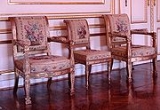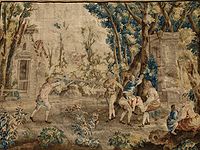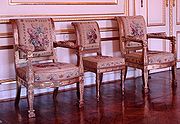
Beauvais tapestry
Encyclopedia
The Beauvais tapestry manufacture was the second in importance, after the Gobelins tapestry, of French tapestry
workshops that were established under the general direction of Jean-Baptiste Colbert
, the finance minister of Louis XIV
. Whereas the royal Gobelins manufacture executed tapestries for the royal residences and for ambassadorial gifts, the manufacture at Beauvais
always remained a private enterprise. Beauvais specialised in low-warp tapestry weaving, though the letters patent of 1664, authorising the company and offering royal protection, left the field open for the production of high-warp tapestry as well.
The first entrepreneur, Louis Hinard, a native of Beauvais who had already established workshops in Paris, produced unambitious floral and foliate tapestries called verdures and landscape tapestries, which are known through chance notations in royal accounts. He was arrested for his debts in 1684, and the workshops were refounded more successfully under Philippe Behagle, a merchant tapestry-manufacturer from Oudenarde, who had also worked in the traditional tapestry-weaving city of Tournai
. Behagle's first successes were a suite of Conquests of the King which complemented a contemporaneous Gobelins suite showing episodes in the Life of the King, without directly competing with them. A suite of Acts of the Apostles, following copies of Raphael's cartoons, are in the cathedral of Beauvais. The so-called Teniers tapestries, in the manner of village scenes painted by David Teniers the Younger
, began to be woven under Behagle and continued popular, with up-dated borders, into the eighteenth century, when the earliest series of archives begin.
The great series of Grotesques (illustration, left) initiated in the 1690s became a mainstay of Beauvais production, woven through the Régence. The cartoons, which were inspired by the engravings of the elder Jean Bérain
and were carried out to cartoons by Jean-Baptiste Monnoyer
, a painter attached to the Gobelins factory, were based on fanciful grotteschi
. Against mustard yellow grounds vases and baskets of fruit with birds, a specialty of Monnoyer's, are contrasted with lively figures, sometimes acrobats and dancers, sometimes from the Commedia dell'arte
in slender and fanciful arabesque architecture.
Behagle continued his private workshops in Paris, as had his predecessor. From these shops came the suite of Marine Triumphs with the arms of the comte de Toulouse. On his death in 1705, the Beauvais manufacture was continued by his wife and son, and in 1711 by new proprietors, the brothers Filleul. Under Filleul ownership Beauvais produced suites of The story of Telemachus and Ovidian Metamorphoses as well as animal combats, and a series of "Chinese" hangings that are a high point in the career of chinoiserie
. Between 1722 and 1726, Beauvais was directed by Noël-Antoine de Mérou, and maintained showrooms in Paris, and in Leipzig
and Ratisbon (Regensburg
), for Beauvais found many commissions among foreigners.
 The great period of Beauvais tapestry begins with the arrival of Jean-Baptiste Oudry
The great period of Beauvais tapestry begins with the arrival of Jean-Baptiste Oudry
, 22 July 1726, replacing the unsatisfactory Jacques Duplessis. When Mérou was dismissed in 1734 for falsifying the accounts, for the first time the manufacture was directed by an artist, since Oudry's financial backer, Nicolas Besnier, a goldsmith of Paris, was wise enough not to interfere with the artistic production, and the partnership lasted until 1753. Oudry was simultaneously inspector of the works at Gobelins. At Beauvais he reorganized the training of the young workers and turned out designs and constantly renewed borders: the New Hunts, the suite of Country Pleasures, the hangings illustrating Molière
's comedies, a renewed suite of perennially popular Metamorphoses. Sets of tapestry covers for seat furniture were introduced, and in September 1737 it was decided that the King of France should purchase two sets of tapestry each year, for 10,000 livres, for gifts to foreign ministers, an advertisement of French hegemony in the field of art and also a fine advertisement for the quality of the Beauvais manufacture. The king had the entire production of Gobelins at his disposal, but as Edith Standen points out, they were rather large, rather solemn and definitely old-fashioned. In 1739, for the first time, cartoons for Beauvais were exhibited at the Paris salon
, another way of keeping the tapestry workshops before the public eye.
 Oudry turned to other artists to supplement the tapestry cartoons he was producing; from Charles-Joseph Natoire
Oudry turned to other artists to supplement the tapestry cartoons he was producing; from Charles-Joseph Natoire
's designs Beauvais wove the suite of Don Quichotte, and from François Boucher
, starting in 1737, a long series of six suites of tapestry hangings, forty-five subjects in all, constituting the familiar "Boucher-Beauvais" suites that embody the rococo
style: the Fêtes Italiennes, a set of village festivals in settings evoking the Roman Campagna, the Nobles Pastorales, a further suite of six chinoiseries, now in a lighter, Rococo handling. Boucher's eight oil sketches for these Tentures chinoises were shown in the Salon of 1742;. It was unusual for the artist's sketches to be enlarged to provide cartoons, as in this case; the translation to cartoons was made by Jean-Joseph Dumons de Tulle. The successful series was woven at Beauvais at least ten times between July 1743 and August 1775; in addition further copies were made at Aubusson
.
Boucher also designed for Beauvais the Story of Psyche and at the apex of the lot, the Amours des Dieux, the "Loves of the Gods", after paintings by Boucher delivered 1747-49; suites from among the nine subjects, though never all subjects in one suite, were being woven at Beauvais as late as 1774.
A new partner, André-Charlemagne Charron, and increased royal support, with annual order for sets of hangings now with complete suites of furniture coverings, to be delivered to the Garde-Meuble de la Couronne or the foreign ministry should have launched new successes for Beauvais, but Oudry's death, 30 April 1755, and Boucher's defection to the Gobelins the same year, initiated a period of stagnation, while the old designs were repeated, and then decline. At the French Revolution
the workshops were temporarily closed, following a dispute between the weavers and the administration, and then were reopened, under State direction, making little but upholstery covers.
Tapestry
Tapestry is a form of textile art, traditionally woven on a vertical loom, however it can also be woven on a floor loom as well. It is composed of two sets of interlaced threads, those running parallel to the length and those parallel to the width ; the warp threads are set up under tension on a...
workshops that were established under the general direction of Jean-Baptiste Colbert
Jean-Baptiste Colbert
Jean-Baptiste Colbert was a French politician who served as the Minister of Finances of France from 1665 to 1683 under the rule of King Louis XIV. His relentless hard work and thrift made him an esteemed minister. He achieved a reputation for his work of improving the state of French manufacturing...
, the finance minister of Louis XIV
Louis XIV of France
Louis XIV , known as Louis the Great or the Sun King , was a Bourbon monarch who ruled as King of France and Navarre. His reign, from 1643 to his death in 1715, began at the age of four and lasted seventy-two years, three months, and eighteen days...
. Whereas the royal Gobelins manufacture executed tapestries for the royal residences and for ambassadorial gifts, the manufacture at Beauvais
Beauvais
Beauvais is a city approximately by highway north of central Paris, in the northern French region of Picardie. It currently has a population of over 60,000 inhabitants.- History :...
always remained a private enterprise. Beauvais specialised in low-warp tapestry weaving, though the letters patent of 1664, authorising the company and offering royal protection, left the field open for the production of high-warp tapestry as well.
The first entrepreneur, Louis Hinard, a native of Beauvais who had already established workshops in Paris, produced unambitious floral and foliate tapestries called verdures and landscape tapestries, which are known through chance notations in royal accounts. He was arrested for his debts in 1684, and the workshops were refounded more successfully under Philippe Behagle, a merchant tapestry-manufacturer from Oudenarde, who had also worked in the traditional tapestry-weaving city of Tournai
Tournai
Tournai is a Walloon city and municipality of Belgium located 85 kilometres southwest of Brussels, on the river Scheldt, in the province of Hainaut....
. Behagle's first successes were a suite of Conquests of the King which complemented a contemporaneous Gobelins suite showing episodes in the Life of the King, without directly competing with them. A suite of Acts of the Apostles, following copies of Raphael's cartoons, are in the cathedral of Beauvais. The so-called Teniers tapestries, in the manner of village scenes painted by David Teniers the Younger
David Teniers the Younger
David Teniers the Younger was a Flemish artist born in Antwerp, the son of David Teniers the Elder. His son David Teniers III and his grandson David Teniers IV were also painters...
, began to be woven under Behagle and continued popular, with up-dated borders, into the eighteenth century, when the earliest series of archives begin.
The great series of Grotesques (illustration, left) initiated in the 1690s became a mainstay of Beauvais production, woven through the Régence. The cartoons, which were inspired by the engravings of the elder Jean Bérain
Jean Bérain
Jean Bérain may refer to:* Jean Bérain the Elder * Jean Bérain the Younger...
and were carried out to cartoons by Jean-Baptiste Monnoyer
Jean-Baptiste Monnoyer
Jean-Baptiste Monnoyer was a Franco-Flemish painter who specialised in flower pieces. He was attached to the Gobelins tapestry workshops and the Beauvais tapestry workshops, too, where he produced cartoons of fruit and flowers for the tapestry-weavers, and at Beauvais was one of three painterswho...
, a painter attached to the Gobelins factory, were based on fanciful grotteschi
Grotesque
The word grotesque comes from the same Latin root as "Grotto", meaning a small cave or hollow. The original meaning was restricted to an extravagant style of Ancient Roman decorative art rediscovered and then copied in Rome at the end of the 15th century...
. Against mustard yellow grounds vases and baskets of fruit with birds, a specialty of Monnoyer's, are contrasted with lively figures, sometimes acrobats and dancers, sometimes from the Commedia dell'arte
Commedia dell'arte
Commedia dell'arte is a form of theatre characterized by masked "types" which began in Italy in the 16th century, and was responsible for the advent of the actress and improvised performances based on sketches or scenarios. The closest translation of the name is "comedy of craft"; it is shortened...
in slender and fanciful arabesque architecture.
Behagle continued his private workshops in Paris, as had his predecessor. From these shops came the suite of Marine Triumphs with the arms of the comte de Toulouse. On his death in 1705, the Beauvais manufacture was continued by his wife and son, and in 1711 by new proprietors, the brothers Filleul. Under Filleul ownership Beauvais produced suites of The story of Telemachus and Ovidian Metamorphoses as well as animal combats, and a series of "Chinese" hangings that are a high point in the career of chinoiserie
Chinoiserie
Chinoiserie, a French term, signifying "Chinese-esque", and pronounced ) refers to a recurring theme in European artistic styles since the seventeenth century, which reflect Chinese artistic influences...
. Between 1722 and 1726, Beauvais was directed by Noël-Antoine de Mérou, and maintained showrooms in Paris, and in Leipzig
Leipzig
Leipzig Leipzig has always been a trade city, situated during the time of the Holy Roman Empire at the intersection of the Via Regia and Via Imperii, two important trade routes. At one time, Leipzig was one of the major European centres of learning and culture in fields such as music and publishing...
and Ratisbon (Regensburg
Regensburg
Regensburg is a city in Bavaria, Germany, located at the confluence of the Danube and Regen rivers, at the northernmost bend in the Danube. To the east lies the Bavarian Forest. Regensburg is the capital of the Bavarian administrative region Upper Palatinate...
), for Beauvais found many commissions among foreigners.

Jean-Baptiste Oudry
Jean-Baptiste Oudry was a French Rococo painter, engraver, and tapestry designer. He is particularly well known for his naturalistic pictures of animals and his hunt pieces depicting game.-Biography:...
, 22 July 1726, replacing the unsatisfactory Jacques Duplessis. When Mérou was dismissed in 1734 for falsifying the accounts, for the first time the manufacture was directed by an artist, since Oudry's financial backer, Nicolas Besnier, a goldsmith of Paris, was wise enough not to interfere with the artistic production, and the partnership lasted until 1753. Oudry was simultaneously inspector of the works at Gobelins. At Beauvais he reorganized the training of the young workers and turned out designs and constantly renewed borders: the New Hunts, the suite of Country Pleasures, the hangings illustrating Molière
Molière
Jean-Baptiste Poquelin, known by his stage name Molière, was a French playwright and actor who is considered to be one of the greatest masters of comedy in Western literature...
's comedies, a renewed suite of perennially popular Metamorphoses. Sets of tapestry covers for seat furniture were introduced, and in September 1737 it was decided that the King of France should purchase two sets of tapestry each year, for 10,000 livres, for gifts to foreign ministers, an advertisement of French hegemony in the field of art and also a fine advertisement for the quality of the Beauvais manufacture. The king had the entire production of Gobelins at his disposal, but as Edith Standen points out, they were rather large, rather solemn and definitely old-fashioned. In 1739, for the first time, cartoons for Beauvais were exhibited at the Paris salon
Paris Salon
The Salon , or rarely Paris Salon , beginning in 1725 was the official art exhibition of the Académie des Beaux-Arts in Paris, France. Between 1748–1890 it was the greatest annual or biannual art event in the Western world...
, another way of keeping the tapestry workshops before the public eye.

Charles-Joseph Natoire
Charles-Joseph Natoire was a French painter in the Rococo manner, a pupil of François Lemoyne and director of the French Academy in Rome, 1751-1775...
's designs Beauvais wove the suite of Don Quichotte, and from François Boucher
François Boucher
François Boucher was a French painter, a proponent of Rococo taste, known for his idyllic and voluptuous paintings on classical themes, decorative allegories representing the arts or pastoral occupations, intended as a sort of two-dimensional furniture...
, starting in 1737, a long series of six suites of tapestry hangings, forty-five subjects in all, constituting the familiar "Boucher-Beauvais" suites that embody the rococo
Rococo
Rococo , also referred to as "Late Baroque", is an 18th-century style which developed as Baroque artists gave up their symmetry and became increasingly ornate, florid, and playful...
style: the Fêtes Italiennes, a set of village festivals in settings evoking the Roman Campagna, the Nobles Pastorales, a further suite of six chinoiseries, now in a lighter, Rococo handling. Boucher's eight oil sketches for these Tentures chinoises were shown in the Salon of 1742;. It was unusual for the artist's sketches to be enlarged to provide cartoons, as in this case; the translation to cartoons was made by Jean-Joseph Dumons de Tulle. The successful series was woven at Beauvais at least ten times between July 1743 and August 1775; in addition further copies were made at Aubusson
Aubusson, Creuse
Aubusson is a commune in the Creuse department in the Limousin region in central France.-Geography:...
.
Boucher also designed for Beauvais the Story of Psyche and at the apex of the lot, the Amours des Dieux, the "Loves of the Gods", after paintings by Boucher delivered 1747-49; suites from among the nine subjects, though never all subjects in one suite, were being woven at Beauvais as late as 1774.
A new partner, André-Charlemagne Charron, and increased royal support, with annual order for sets of hangings now with complete suites of furniture coverings, to be delivered to the Garde-Meuble de la Couronne or the foreign ministry should have launched new successes for Beauvais, but Oudry's death, 30 April 1755, and Boucher's defection to the Gobelins the same year, initiated a period of stagnation, while the old designs were repeated, and then decline. At the French Revolution
French Revolution
The French Revolution , sometimes distinguished as the 'Great French Revolution' , was a period of radical social and political upheaval in France and Europe. The absolute monarchy that had ruled France for centuries collapsed in three years...
the workshops were temporarily closed, following a dispute between the weavers and the administration, and then were reopened, under State direction, making little but upholstery covers.

